Early Theatre Deep Dive: David Tennant in 'What The Butler Saw' (1995)
...we talk about ~that~ play and (yes maybe even) ~that~ picture
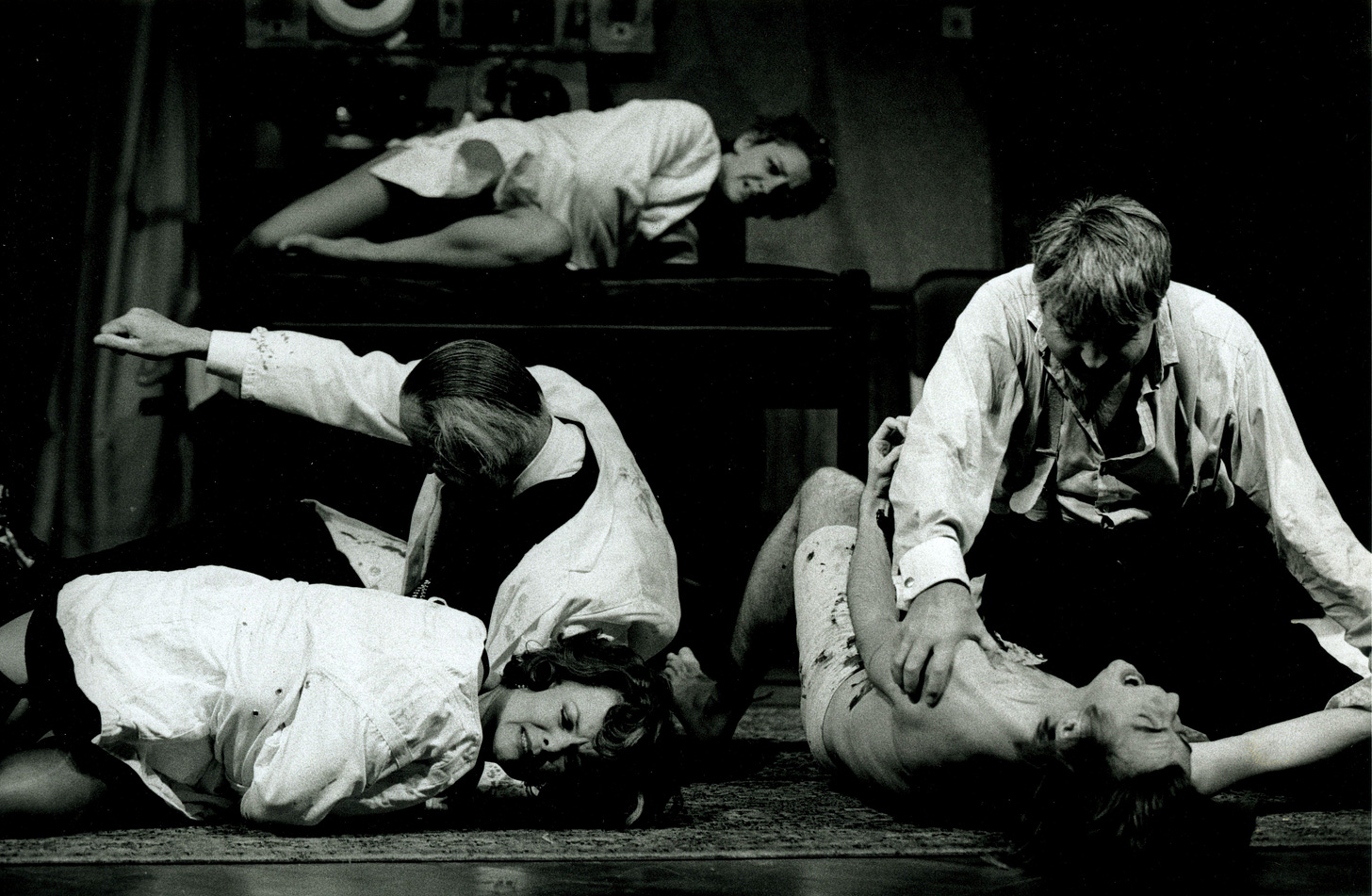
About a month ago now, I did my first in-depth exploration into one of David’s early plays with a specific view towards collecting its programmes. That play was 1995’s What The Butler Saw.
If you’re interested in reading my post about What The Butler Saw’s plethora of programmes before we get started here, simply click below and then scurry on back here:
Annnnnd we’re back!
Alongside the previous year's BAFTA-winning Takin' Over The Asylum, David’s role as Nicholas Beckett in What The Butler Saw almost certainly helped open doors for him. It was a production which David has said was one of those watershed moments in his career. After it closed, David immediately moved on to play Kenny in An Experienced Woman Gives Advice (which won him an award) and as Touchstone a year later in As You Like It.
So, as this year is the play’s thirtieth anniversary, what better time than now to delve a bit deeper into the production, eh?
Joe Orton’s What The Butler Saw was written in 1967 and was finished only a few weeks before Orton’s murder at the hands of his lover, Kenneth Halliwell. It’s a sex farce comedy-cum-twisted melodrama in two acts which takes place in the consulting room of an exclusive private psychiatric clinic.
The play’s plot is an extremely complicated one full of absurdities and slapstick, with lots of crossed wires and sexual situations. It was well-known as the show which “had something to offend everyone.”
You can read a summary here, or if you’d rather, a simplistic way to explain it is like so:
An apparently successful psychiatrist finds himself in a situation when his wife walks in on him seducing a girl applying for a secretary's job. To complicate matters, the wife has brought home [the bellhop/pageboy, who happens to be a sex fiend] who is trying to blackmail her [into giving him the secretary’s job]. The apple cart is further upset when a [fellow psychiatrist and] government [inspector of lunacy] pulls a surprise inspection, and the doctor and his wife try to conceal their mistakes. The absurdity is carried one step further upon the entrance of a policeman looking for the girl, but the boy thinks the cop is after him. What follows is a madhouse of embarrassment…[an escalating frenzy of blackmail, transvestism, incest and more...]
You’re also probably wondering why it was called What The Butler Saw.
Orton’s title came from the name of a late 1890s-early 1900s erotic “film” of a woman partially undressing in her bedroom. The film was screened through a Mutoscope, a motion picture machine which was like a huge Rolodex with a handle the user cranked to rotate the photos and make them appear to be moving. (If you’re still confused about how this works, you can see one in action here.)
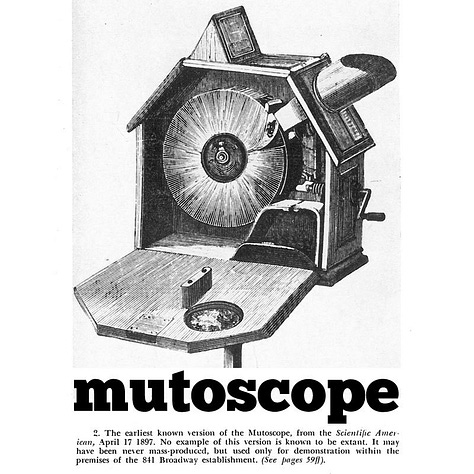
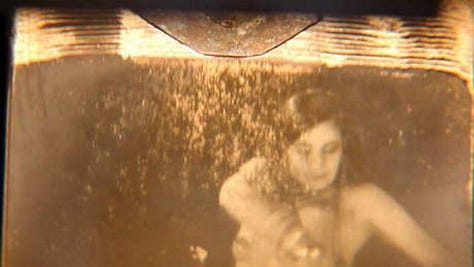
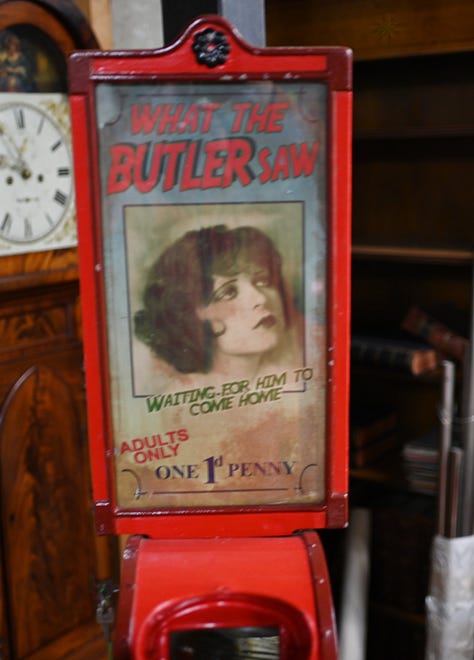
In turn, the early 20th century film had been named for a real-life scandal involving
a sensational divorce case in 1884 between Lord Colin Campbell, a son of the Duke of Argyll, and his wife Gertrude, a celebrated beauty of the age...Campbell claimed that Gertrude had been carrying on with a string of men…To back up his case, Campbell brought in his butler, who claimed to have watched Gertrude’s lovemaking with different men through the keyhole of her bedroom.
The issue became so heated that the judge adjourned the trial to the Campbell’s London house so that jury members could peer through the keyhole themselves and decide just how much the butler could have really seen. The phrase “what the butler saw” was used widely in newspapers – and has stuck ever since.
To my knowledge, David’s never explained in detail how he got the audition for the play, but according to a conversation he had with Donna Franceschild on one of the commentary tracks included on the Takin’ Over The Asylum DVD, it appears the National Theatre casting department had been to see him in a previous play when they were hunting for someone to play the role of Nick. I included the entire conversation in my last post about And The Cow Jumped Over The Moon, so I’ll summarize it briefly: basically, the quality of David’s role as Campbell in Takin’ Over The Asylum was his saving grace, for the National Theatre hadn’t been particularly impressed with his 1994 portrayal of Alan in Slab Boys Trilogy at the Young Vic!
What The Butler Saw was directed by Phyllida Lloyd (who later directed Mamma Mia) and debuted at the National’s Lyttelton Theatre in London in previews from 24 February 1995.
The production starred Richard Wilson (Dr. Rance), John Alderton (Dr. Prentice), Debra Gillett (Geraldine Barclay), Nicola Pagett (Mrs. Prentice), David as Nicholas Beckett, and Jeremy Swift (Sergeant Match).
Of the cast members, Alderton, Pagett and Wilson were the three best-known entities. Alderton was known from his roles in Upstairs, Downstairs and for narrating and voicing all the characters in the original series of Fireman Sam. Pagett’s breakout role was as Elizabeth Bellamy in Upstairs, Downstairs, but at the time of her casting in What The Butler Saw, she was known for starring in the sitcom Ain't Misbehavin' alongside Peter Davison.
However - even though Alderton and Pagett both had many credits to their name on both stage and screen - it was Richard Wilson who drew the most press. At the time, Wilson was one of the most well-known men in Britain, and it’s hard to understate just how much of an impact his involvement in What The Butler Saw had for its success. He certainly helped the play sell out all across the UK.
You see, at the time Wilson was at the height of his fame playing the perennially grumpy Victor Meldrew in the iconic BBC sitcom One Foot in the Grave. But it was the BBC who ended up grumpier when Wilson let them know he was skipping out on filming a new series to spend nine months playing Dr. Rance in What The Butler Saw. Wilson said he wanted to do something different, and he needed the break.
The press for What The Butler Saw couldn’t stop making pun-filled comparisons between Wilson’s Meldrew and his Dr. Rance (which sounds very familiar to those of us who are David’s fans, because we know not a single interview David gives fails to mention his stint as the Tenth Doctor in Doctor Who!)
The other two cast members were less known at the time. Debra Gillett, who portrayed Geraldine Barclay, had done a few films (Witches, Riff-Raff) and TV series (Chimera, Truckers) before joining the production. Gillett later starred as Rita Connolly in the Doctor Who episode, ‘The Idiot’s Lantern’! And Jeremy Swift (who portrayed Sergeant Match) was a jobbing theatre actor before joining the production, but since then, he’s went on to star as Mr. Spratt on Downton Abbey and as Leslie Higgins on Ted Lasso.
There’s one other piece of trivia I can’t resist sharing about Debra Gillett. She later went on to marry playwright Patrick Marber, who she met in 1995 during her run as Geraldine. David met Marber that same night. Years later, David happened to mention to Gillett that he was looking to return to the stage, and Gillett mentioned it to Marber. Marber then sent David a play he’d adapted - Don Juan in Soho!
—
What The Butler Saw came in at just about two hours, including a 20-minute interval, and had its opening press night on 2 March 1995. It ran at the Lyttelton until 12 April 1995.

Many of the production’s photos were taken by official production photographer Mark Douet, most likely during rehearsals and then during its initial run at the Lyttelton. I do know, though, that photographers Alastair Muir and Donald Cooper also took photos during the play’s run.
I’ve added a few photos which feature David below. It’s notable they all feature him during the part of the play where he masquerades as Geraldine Barclay wearing a leopard-skin mini and a blonde wig. I’m not sure why this is, as he spends most of the play wearing other clothing - boxer shorts, a bellhop’s uniform, and a policeman’s uniform - and I know other photos were taken with him in these other costumes, since I’ve seen those photos myself. But I guess the photos of him in the leopard-skin mini were the ones they chose for general release.
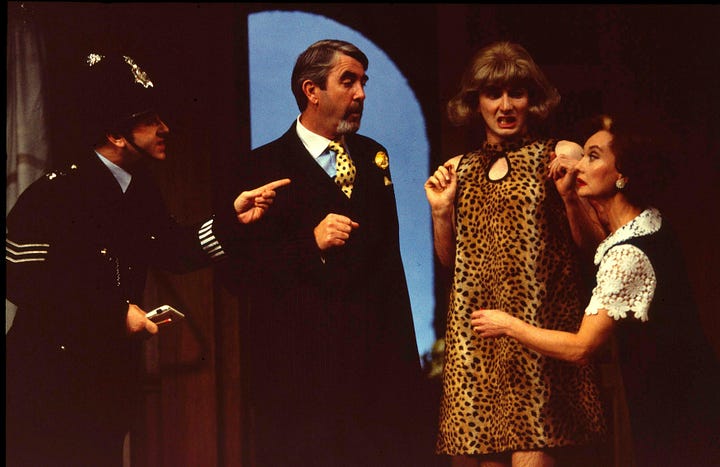
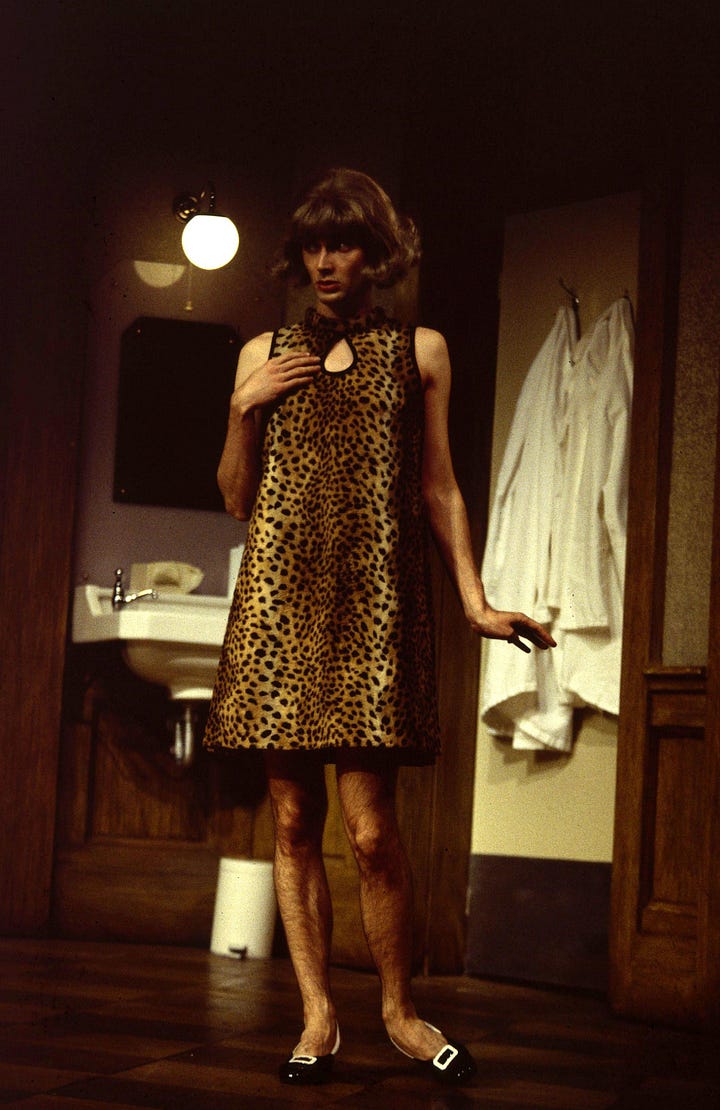
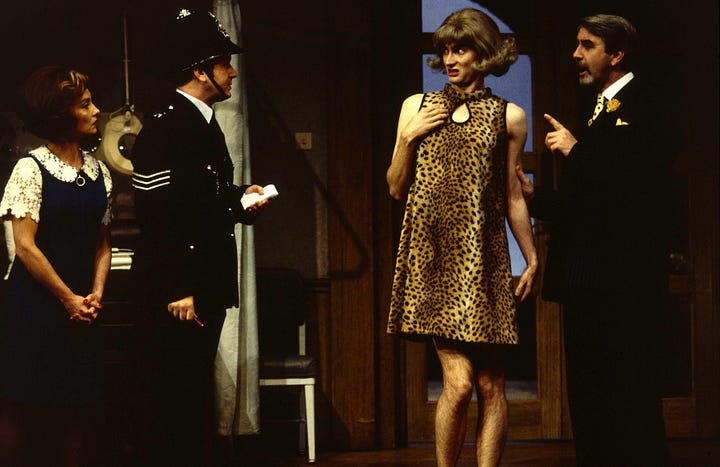
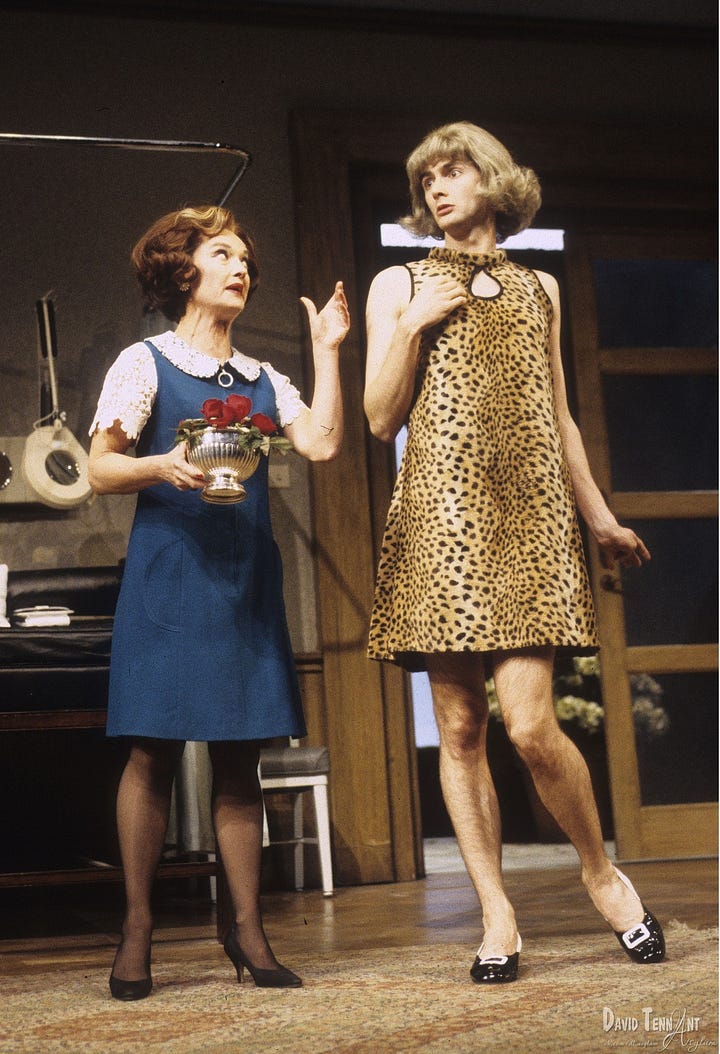
As I said, David portrayed Nicholas Beckett, a bellhop/pageboy at the Station Hotel. Beckett is actively trying to blackmail Mrs. Prentice, the psychiatrist Dr. Prentice’s wife, into getting him a job as her husband’s secretary. He holds photographs of his liaison with Mrs. Prentice, and threatens to show them to the Doctor unless she does as he demands.
According to a friend of mine who watched What The Butler Saw at the NT Archive in London, David was a “very acrobatic Nick”. It was much the same as he would play the role of Brindsley Miller three years later in The Real Inspector Hound/Black Comedy, a play I’ve already done a deep dive on:
My friend said David (as Nick)
…spent most of the latter part of the play bloody and writhing on the floor in his underwear, or crawling across the stage, arse in the air and head to the floor, moaning and whimpering.
My favorite moments were when he gets into a scuffle and the Doctor flips him head over heels. It was pretty impressive, acrobatically speaking.
After that, as the tussle continues, DT does two backwards somersaults on the floor! He’s certainly limber, I’ll give him that!
Reviews for the show ran the gamut, earning every sort of reaction from effusive praise to ho-hum, fair-to-middling shrugs.
I’ve included a few of these reviews below. They cover both the play’s initial Lyttelton Theatre run in London as well as its later regional tour:
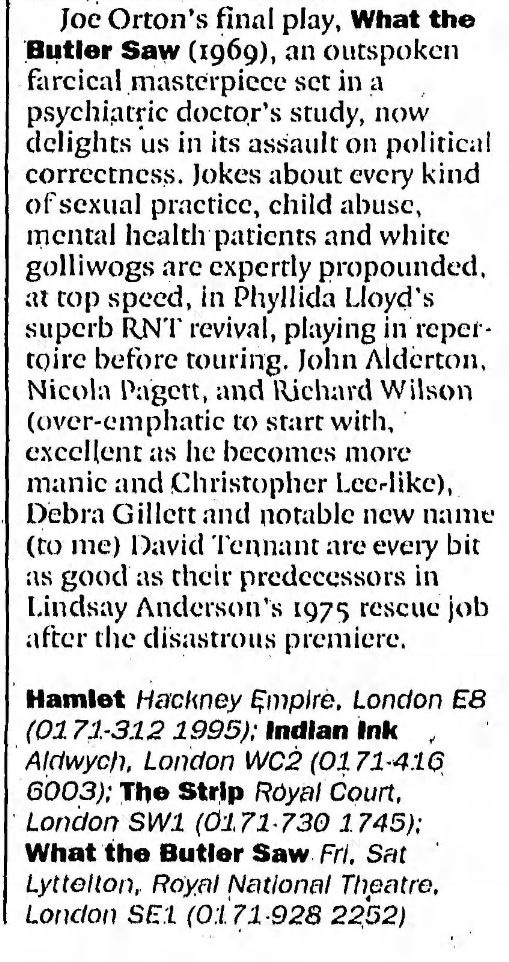

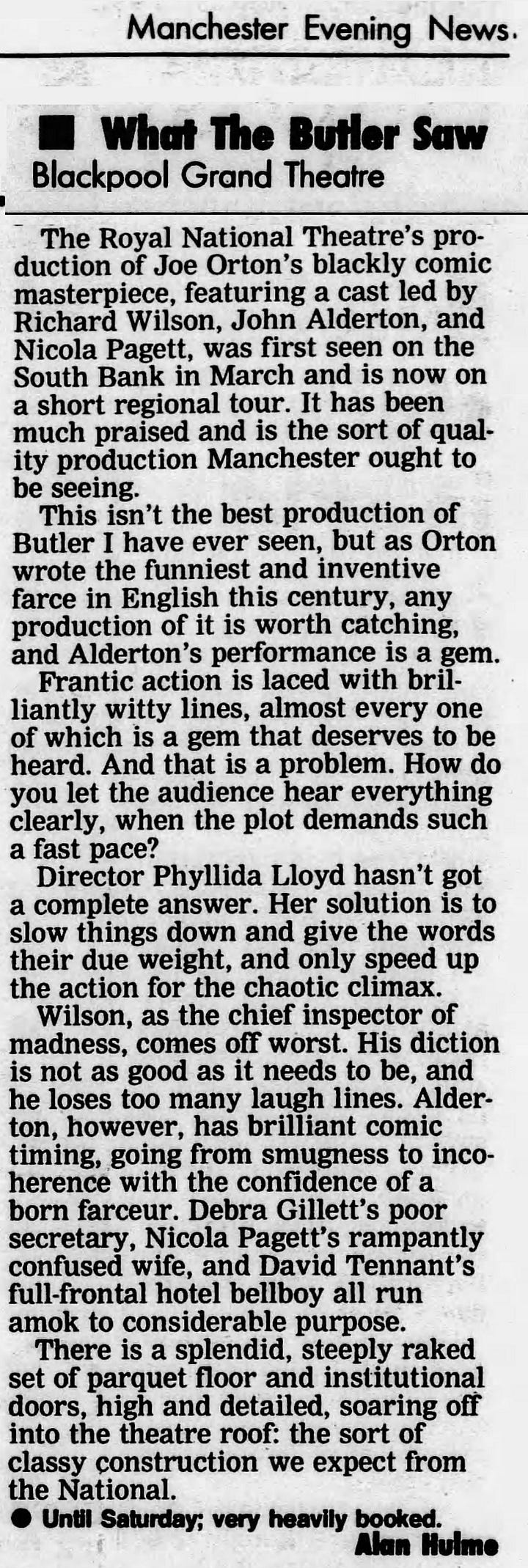

Reviews of David's performance in particular were also varied.
The Observer said David was a “notable new name.” What's On called him a “bellboy on the make”, while the Financial Times said he was “rather too artificial, either as the hotel pageboy or (better) disguised in a leopard mini-dress.” And The Daily Mail called him a “beanpole bellboy of rapaciously ambivalent sexuality.”
Oh! Speaking of the bellboy…
We’ll digress here for a moment to talk about the bellboy costume David wore in the play. In late December 2006, David attended Matt Lucas’s fancy-dress wedding reception, and a few days later he participated in a Virgin Radio Christmas Panto (as well as its pre-show) with Christian O'Connell as a character called “Buttons”.
He was dressed in a bellhop’s uniform, and this long-ago Tumblr post by the lovely mizgnomer captured David’s explanation of the costume:
Christian: Now when are you going to go and get ready? 'Cause you brought your own fancy outfit and everything.
David: You know, I had an outfit, I was at a party at the weekend... a little fancy dress ball.
Christian: Matt Lucas' wedding
David: Well, yeah.
Christian: That's a party to you?
David: I don't like to name drop. We all had to go in fancy dress - pantomime fancy dress.
Christian: It looked amazing! Elton John was there... Jonathan Ross...
David: Yeah, yeah, yeah... and I thought, where do you get...? I was in a play 12 years ago, you see, and I had to play a bellboy, so I re-hired...I had to pay the National Theatre to re-hire the costume they'd once made for me off them!
Christian: You're not saying that coming and doing this gig has actually cost you financially?
David: Well, I doubled up. I thought, I've got it for a week, I'm going to make the most of it!
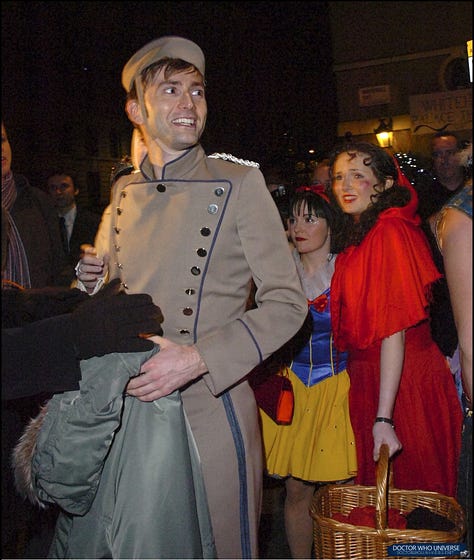
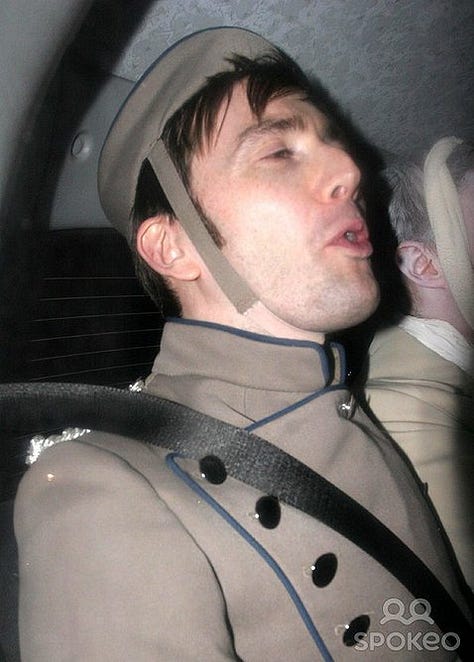

Now back to What The Butler Saw!
After its run at the Lyttelton Theatre in London ended, the production took a two-week break before it moved on to do a regional tour at four other venues:
the Theatre Royal Bath (25-29 April 1995),
the Blackpool Grand Theatre (2-6 May 1995),
the Theatre Royal Norwich (9-13 May 1995),
and the Theatre Royal Nottingham (16-20 May 1995).
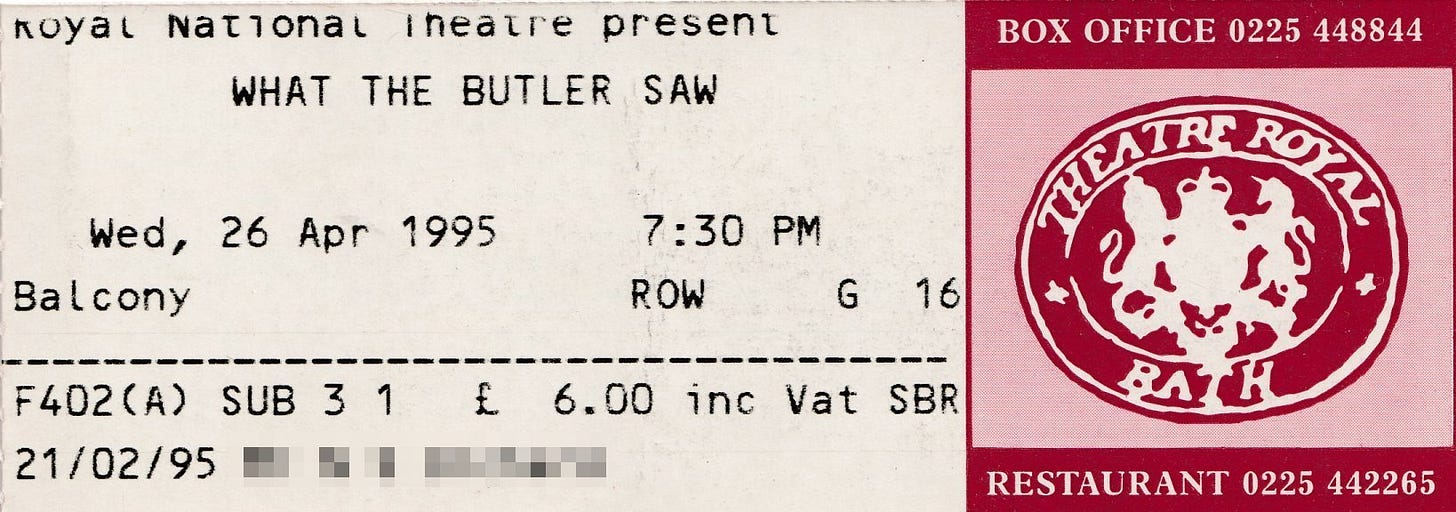
One interesting thing I learned about What The Butler Saw’s run in Nottingham was that there was a unique meet and greet opportunity during its run there.
On the night before the play was scheduled to close at the venue, Jaguar Cars sponsored a special corporate post-show dinner. Jaguar’s guests attended the show that evening.
Afterwards, an intimate dinner was laid out on the upper floor of the Theatre Royal, and at each place setting was a card which read, ‘Jaguar Cars Welcome You To This Evening's Performance of 'What The Butler Saw' (by Joe Orton) on Friday 19th May 1995 at the Theatre Royal, Nottingham.’ David attended this dinner along with Richard Wilson and John Alderton, and the guests were able to chat with the three stars of the show and obtain their autographs if they so desired.

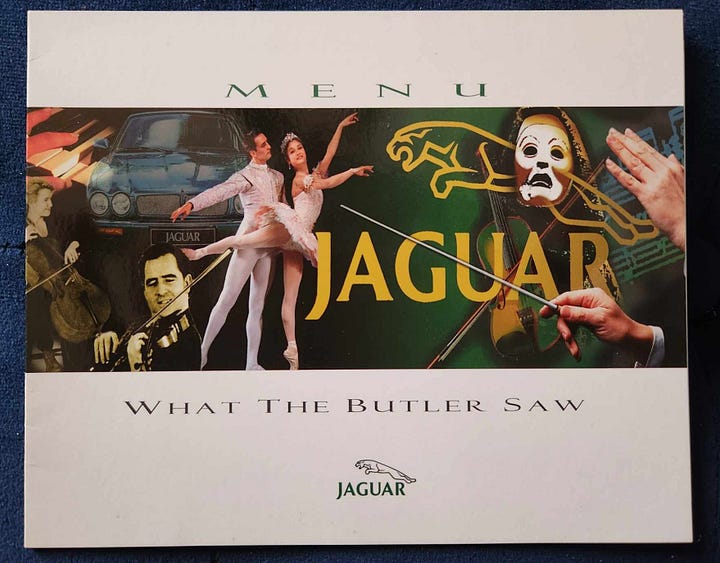
Now wouldn’t THAT have been a fabulous dinner to attend?
Though I haven’t been able to confirm it, I think it’s safe to say there were probably more of these sorts of things during the production’s run (though on the whole, maybe not all were as specific and involved). That is to say, many productions hold some variation of pre- and post-performance talks with cast and crew, and I can’t imagine What The Butler Saw was much different. Often these sorts of events were listed in the production’s programmes, but there aren’t any in What The Butler Saw’s case. Now that of course doesn’t mean there weren’t any. It just means I haven’t been able to find other instances.
After the regional tour was over, the cast took another short break. They then cycled back to the Lyttelton to do another run at the theatre - but this time in rep (i.e., instead of performing each night, they rotated nights with two other productions).
What The Butler Saw started in rep on 25 May 1995 and did six performances in May, twelve performances in June, five performances in July, eleven performances in August, four performances in September, and five performances in October.
During the play’s run in rep, some interesting things happened.
First, Richard Wilson had been awarded an OBE for his services to drama by Queen Elizabeth in June 1994 and was scheduled to receive it in May 1995. Wilson chose not to receive it at Buckingham Palace by the Queen (as is traditional) but by the Queen’s representative after an evening performance of the show on 27 May 1995 at the Lyttelton!
Secondly - as mentioned in my previous post on collecting the What The Butler Saw programmes - Nicola Pagett played the role of Mrs. Prentice until sometime in late May or early June 1995 (i.e., either at the end of the play’s regular run, or just after it began to play in rep). She had to leave the production when she suffered a breakdown due to untreated bipolar disorder.
Pagett’s 1997 memoir Diamonds Behind My Eyes related how she fixated on Orton, became obsessed with the character of Mrs. Prentice, danced and paced in her dressing room, and hardly slept. Eventually, her months of erratic behavior escalated to the point it could no longer be ignored. It was reported by her colleagues and friends, and she had to leave the role in order to seek treatment.
Pagett’s colleagues at the time, of course, were the other five cast members of What The Butler Saw.
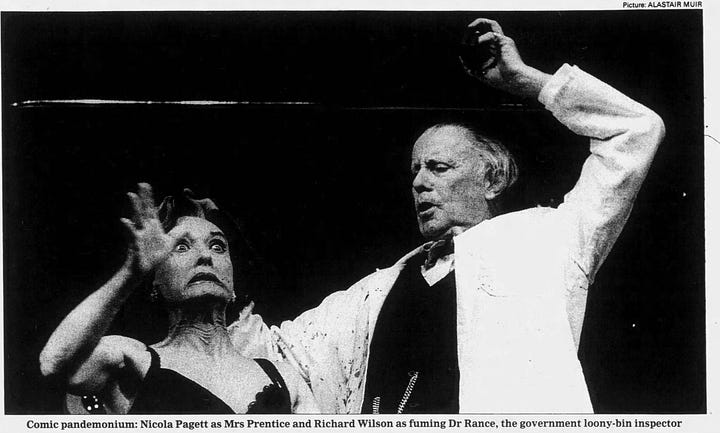
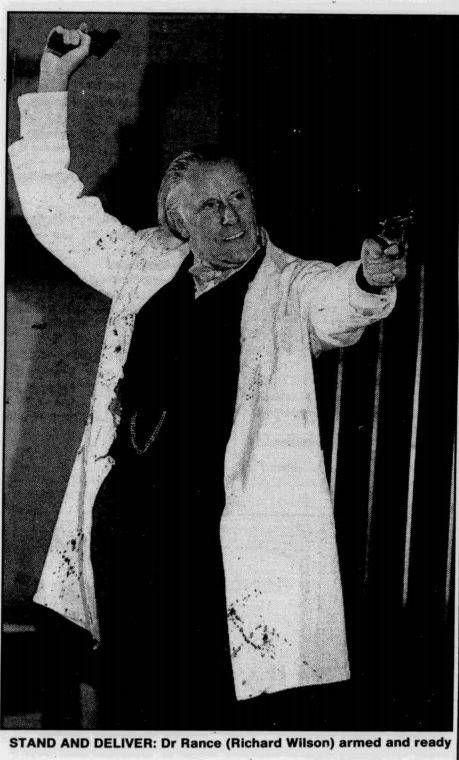
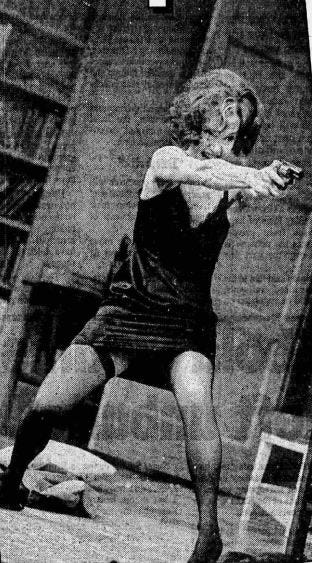
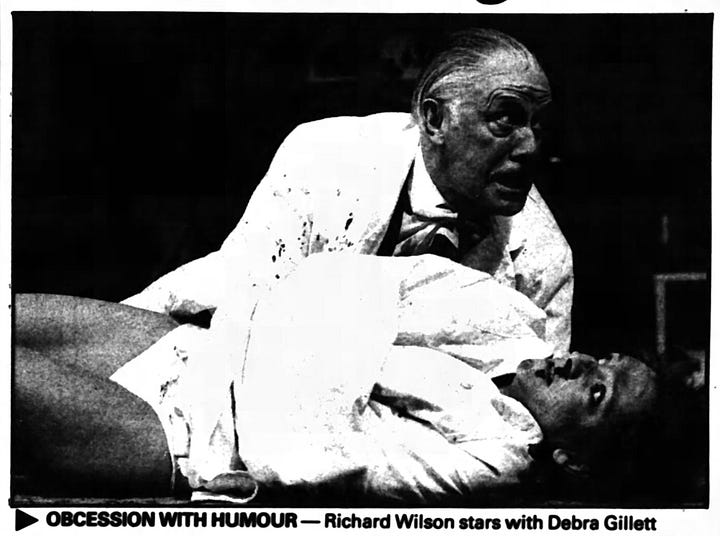
Though I could find little to nothing said about it in the press, it must have been quite a disruption when the role had to be re-cast in the middle of the run at short notice. But as they say, the show must go on. Isla Blair took Pagett’s place for the rest of the run, and different posters, programmes and flyers were printed featuring Blair on their covers (which I covered elsewhere in my aforementioned previous post about how to tell What The Butler Saw programmes apart).
As most of the reviews done and photos taken during What The Butler Saw were taken during its initial run with Pagett in the role, it’s rarer to find any including Blair. Because of this, I’ve included two newspaper blurbs featuring Blair below, as well as a photo of Blair in the role as my top photo for this post.
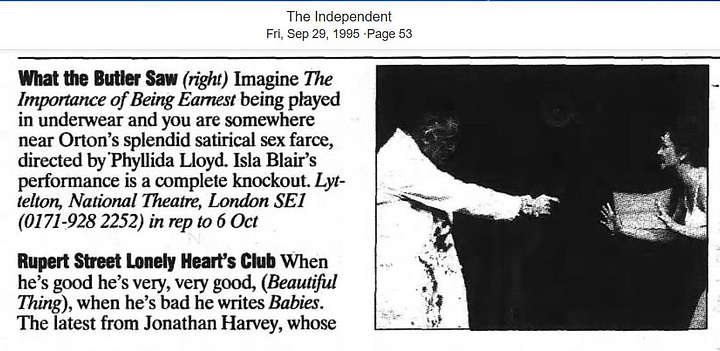
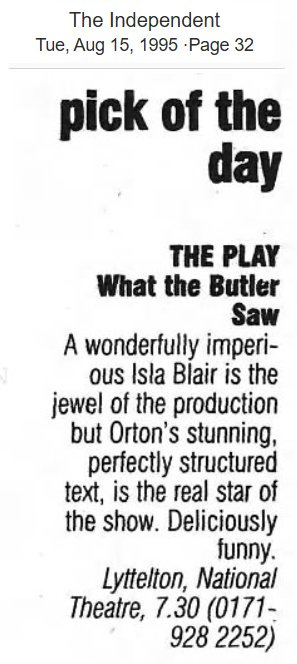
What The Butler Saw completed its final performance on 7 Oct 1995.
On 5 October 1995, two days before the play closed for good, the National Theatre Sound Department recorded its evening performance.
Today, the National Theatre Archive holds a viewing copy of the play, and you can make arrangements to view it on premises at The Cut in London by simply heading over to its entry at the National Theatre Archive website and clicking on the “Contact Us” link on the left sidebar to reach the archivists:
You’ll note this entry says, “Digitised from VHS recorded by National Theatre Sound Department. Lower quality video.” Yup. And I’m sad to report that while the NT Archive holds the master recording copies of the play, too, they’re also noted as being of lower quality video.
So, while we’ll just have to suck it up with regards to the quality, I guess we’re lucky to have it at all. It’s from 1995, and they recorded it on VHS. I suppose beggars can’t be choosers.
For lack of a better term, I can attest the video quality just sort of sucks. It’s viewable and you can hear the sound all right, but the picture quality is dismal - it’s foggy and unfocused. I watched it (and The Pillowman) during a visit I made to London in 2017. My thoughts on The Pillowman are for another day, but with regards to What The Butler Saw? I can only say that while I enjoyed watching David’s performance as Nick and thought he and the other cast members held their own…honestly? I wasn’t as sold on the play itself.
If you decide to watch it, it might help to know why Orton wrote the play to begin with. He wrote What The Butler Saw as a send-up of what he thought were major issues with British culture. First, he mercilessly mocked the establishment, and the authority figures he peppered about in the play showed his disdain; his policemen were blundering, easily-deceived halfwits, and his psychiatrists and government inspectors became egotists and perverts instead of well-respected men of science.
But perhaps most importantly, Orton believed rigid moral codes harmed both individuals and society…and as a gay man in the 1960s, he experienced all of this firsthand. What The Butler Saw was a evisceration of psychoanalysis, and with his pen, Orton sneered at then-popular Freudian psychosexual theories and what he saw as the ridiculous sexual repression going on in UK society. In response, Orton filled What The Butler Saw with every sort of what he hoped repressed Britons would consider “sexual deviancy”.
The 28 April 1995 edition of the Manchester Evening News put it this way:
One of the greatest farces of all time - Wilde on speed, Coward on cocaine - Butler is a knock-about comedy with a purpose. It's a no-holds-barred indictment of British society in which the innocent are crucified, the mad are in charge of the asylum, and all eventually survive the orgy of cross-dressing and mistaken sexual identity to reach the final curtain bleeding, drugged and drunk.
Still - even knowing why Orton wrote the play - I struggle with farces even on a good day. I tried, but I found its premise and situations made it too much of a period piece. It’s definitely a play of its time, and a lot of its humor, plot devices, and caricatures don't hit with the same shocking punch they would have in the 1960s. I noticed while reading reviews this feeling was already becoming apparent in the 1990s, and today in the 2020s with our modern sensibilities and views on feminism, misogyny, consent and sexual politics, it would hit even less so.
But all that said, I respect Orton for writing something that made them shake in their shoes and clutch their pearls. It just wasn’t for me.
If you’d like to watch a production of the play and judge for yourself, there are a number to choose from. I found this 1987 production of What The Butler Saw on YouTube. It features Prunella Scales and her real-life husband Timothy West (who in 1991 also happened to have taught David in masterclass workshops while he was in drama school - a subject I wrote about at an earlier date) in the starring roles of Dr. Rance and Mrs. Prentice.
—
ETA: Since so many people were asking me after I published this, I thought I’d go ahead and add a link to a PDF of the play. So here you go!
—
And now at long last…we come to something I mentioned at the top of the post: that photo.
There is one What The Butler Saw scene in particular that’s rather…err…iconic amongst David’s fans. In this scene, Nick - who’s dressed as a girl in a leopard-skin dress - and Dr. Prentice plot to get Nick to change clothes with the policeman Sergeant Match (Jeremy Swift) so Nick can arrest himself to escape Dr. Rance’s plan to commit him to an asylum…
(…and yes, goodness, I KNOW how confusing that sounds! The play’s full to bursting with cross-dressing and exchanging identities, and it would take an entirely new article to even begin to explain them all. So just pretend you understand and nod your head with me here, eh?)
Annnnyway, Dr. Prentice gives Nick Sergeant Match’s uniform, and Nick is wearing nothing but his boxers…or at least he is in Orton’s original script. But in Lloyd’s version (as well as in many other British productions - US productions don’t seem to follow the same lead) Nick isn’t wearing boxers, but is instead completely naked!
And yes, my friends, that meant David was onstage in the nude.
This is the “origin story”, so to speak, of the certain set of professional photos taken by Mark Douet of David in the production which have circulated for decades. Some of these photos include other scenes where David’s wearing boxers, but there are a number of photos of the scene just described above. These include one which shows a nude David strategically holding the policeman’s uniform (sans the hat) which Dr. Prentice has just given him. There are also a few others of the scene which follows, where Nick encounters Mrs. Prentice whilst naked and carrying only the policeman’s hat.


The photos I’ve included above are two of the photos Douet snapped of David in this scene. There’s another - the most famous one of all, surely! - which features full-frontal nudity, and it’s the one I imagine everyone who knows about it can’t help but think about when discussing David’s role in this production.
If you’ve seen the photo I’m speaking of or you’ve heard rumors about its existence, that’s great…but if you don’t, I’m sorry to tell you that you won’t be able to depend on me to provide you with the photo in this post. I’ve talked about it, but seeing it isn’t something I feel comfortable posting here. So, ya know…Google is your friend.
I will, however, share a remarkable little snippet of film I came across well over a decade ago now, stashed in some remote, obscure corner of the internet I don’t even recall: a clip from the play! It’s only 16 seconds long, its completely silent, and it’s quite possibly the worst quality snippet you could ever watch. But it’s of that scene, so…yeah.
Here it is in all its glory, but good luck espying anything of substance:
David absolutely knows the photo exists in internet spaces. He’s touched on it explicitly a number of times, most memorably on the 2007 late night UK show The Friday Night Project and in Kirsty Young’s 2009 Desert Island Discs interview. He also references it in much more subtle ways, as in the following exchange on 6 April 2016 during his long-form SAG-AFTRA interview in New York City with interviewer Richard Ridge:
Ridge: What do you remember about that experience, and what that did for your career?
(The way David pauses first, letting his impish smile tell us we know he’s thinking of that infamous photo! He lets it say everything he doesn't say out loud.)
David: “I remember going up for it and thinking, I've got an audition at the National. And then getting the part...it was a huge moment, it felt like I'd been kind of accepted. I got to play at this theatre where I'd gone to see things and marveled. And I was going to be in a play with Richard Wilson, who at the time was I think the most famous man in the country...he was a massive star, but also from Greenock. It was huge for me, enormous that I got this job. And I loved it. I had a fantastic time.”
That picture aside, David gained quite a lot in doing What The Butler Saw. Of course he was able to gain valuable experience in his craft. And as I said in the introduction to this article, having the production on his resume also helped him to secure later roles, like Kenny in An Experienced Woman Gives Advice (which premiered directly after What The Butler Saw and won him awards besides) and as Touchstone in As You Like It a year later.
But he also gained something much more fulfilling, I’m sure: his co-star Richard Wilson became one of his lifelong friends and mentors.
So this is where I, too, will leave What The Butler Saw - with David saying he had a fantastic time. It’s a pretty great place to end the tale!







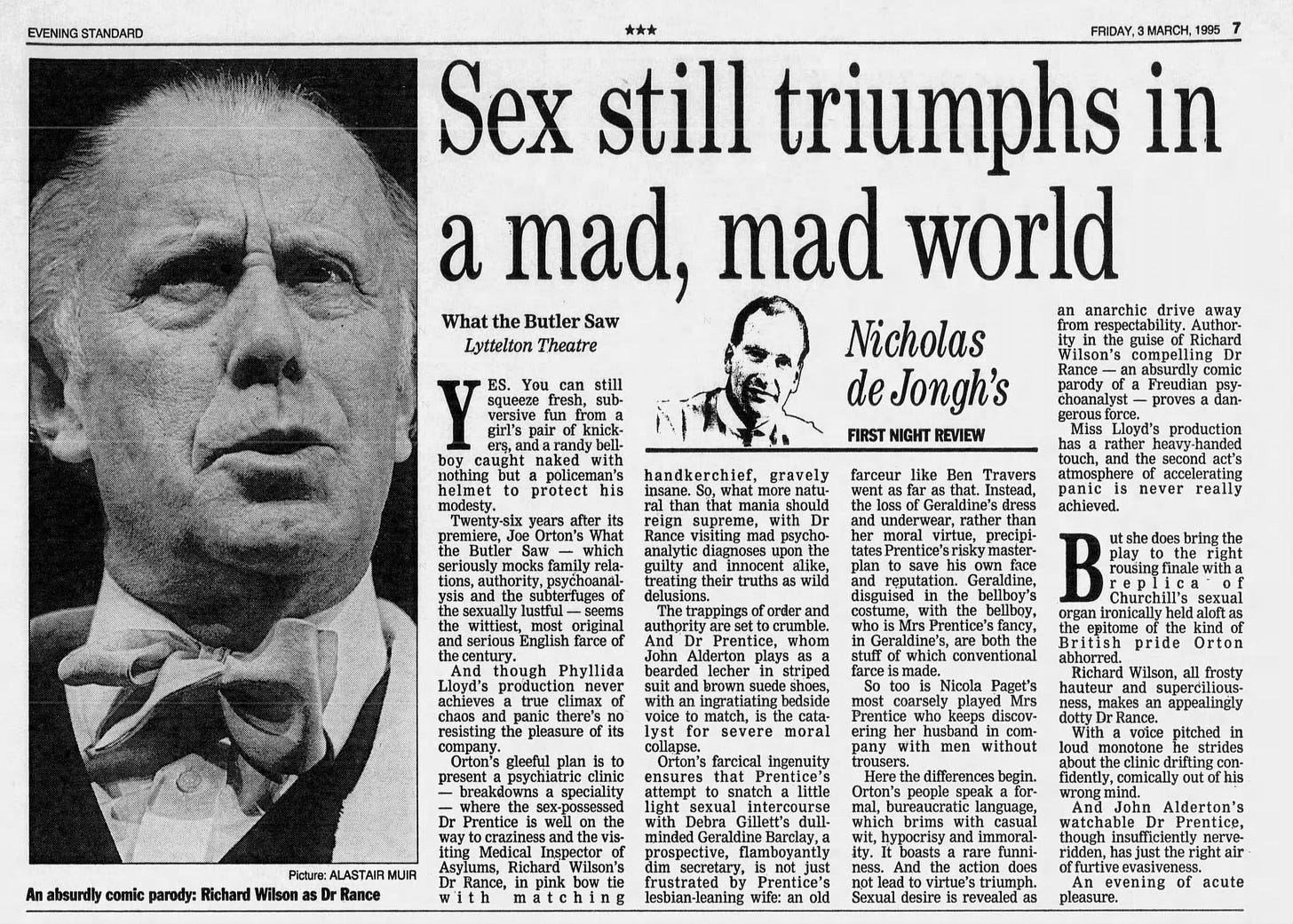

Wow! I've been a DT fan for a long time but had never managed to come across that particular clip! Thanks so very much for sharing the out-of-focus-fleeting full-frontal. :)
Thanks too for the mention & link to my (ancient) Tumblr post! Like you, I'd wondered about the choice of photos released for this production, and wished there was one of DT in the bellboy costume (I've seen blurry photos of some) and a nicer one with DT & Richard Wilson in the same frame.
Back when I was on my quest to watch some of DT's early theatre work whenever I found myself in the UK, friends had warned me away from this one for reasons similar to what you've mentioned here. I still may do it someday if I run out of other productions to see.
Thank you again!!! As always, what an excellent write-up!
LOL, I have That Picture in my Doctor Who folder, lol. I enjoyed that little snippet that you included. That man is skin and bones, lol.